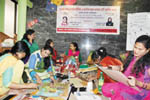Art Therapy For Acid Attack Survivors
Healing mental and emotional trauma through painting
 It was supposed to be like any other regular interview, but of course, it wasn’t. And it was a memorable interview not because the interviewees were six acid attack survivors, but because of who they are, apart from the injustice that happened to them and the label that the society tends to attach with them. Every interview doesn’t end up with the interviewees pouring their hearts out. Pablo Picasso, the Spanish master had said that ‘the purpose of art is washing the dust of daily life off our souls’. Keeping that in mind, it seemed that all the six ‘acid victims’ (a label attached by the society that they are not comfortable with) have mastered the art of living way more than many of us have. Orneka Maharin, Rexona Akhter, Hamida Begum, Jhumur Akhter, Monsura Khatun and Sharmin Akhter, had all been victims of one of the most despicable crimes imaginable, but the society, according to these courageous women, seems to not let them forget that by identifying them as acid victims with a negative connotation. As if, they are not normal, regular people anymore. Well, they aren’t, but not in the sense that the society thinks. They are extraordinary because of what they have overcome, both in the past and present. How they have mastered the art of living according to Picasso’s words is that they regularly wash or at least try to wash the dust that society directs to them.
It was supposed to be like any other regular interview, but of course, it wasn’t. And it was a memorable interview not because the interviewees were six acid attack survivors, but because of who they are, apart from the injustice that happened to them and the label that the society tends to attach with them. Every interview doesn’t end up with the interviewees pouring their hearts out. Pablo Picasso, the Spanish master had said that ‘the purpose of art is washing the dust of daily life off our souls’. Keeping that in mind, it seemed that all the six ‘acid victims’ (a label attached by the society that they are not comfortable with) have mastered the art of living way more than many of us have. Orneka Maharin, Rexona Akhter, Hamida Begum, Jhumur Akhter, Monsura Khatun and Sharmin Akhter, had all been victims of one of the most despicable crimes imaginable, but the society, according to these courageous women, seems to not let them forget that by identifying them as acid victims with a negative connotation. As if, they are not normal, regular people anymore. Well, they aren’t, but not in the sense that the society thinks. They are extraordinary because of what they have overcome, both in the past and present. How they have mastered the art of living according to Picasso’s words is that they regularly wash or at least try to wash the dust that society directs to them.
To help them heal, Fahmida Hossain Urmi, a noted Canadian based Bangladeshi artist conducted a workshop titled ‘Creative Art Therapy heals physical and mental trauma’ from September 28-30 at the Banani office of Acid Survivors Foundation. Art therapy is an art-making process that serves as a therapeutic experience for the artist. Fahmida was first introduced to the concept of art therapy at a workshop at Montreal, Canada. Fahmida told New Age, ‘Scientific research has revealed that the centre in the human brain that is responsible for storing all the mental and emotional pain and trauma is also the centre that is involved with all kinds of creative work. Thus, when someone engages that particular centre in the brain for creative work, the centre releases the pent up emotions and trauma. The more creative work you do, the more negative emotions you release.’
The workshop however was only the beginning, as Fahmida conveyed that after being introduced to the concept of art therapy and the hands on training, the participants are encouraged to continue their works whenever they feel like.
Orneka Maharin, one of the participants at the workshop, informed, ‘Even though Fahmida left for Canada after the workshop concluded, all of us regularly paint and send the pictures of our works to Fahmida on Facebook. All of us have become friends with Fahmida and it feels great’.
Organised by Acid Survivors Foundation (ASF), the workshop was planned and carried out by Fahmida. Laksna Lucky, a psychology graduate programme officer working for the Women Affairs Department of ASF was also associated with the workshop.
‘Before the workshop started, I was pretty anxious as I had never attempted painting before. But while attending the workshop, it felt like a wonderful experience. It really does help one release trauma and anxiety,’ said Maharin. One of the paintings that Maharin made turned out to be quite good for a novice. The work juxtaposes the materialistic city life and simplistic rural life together.
Rexona Akhter, in one of her works has also brought together contrasting ideas. On one hand, the painting has a happy image of two women hugging each other in the crop fields. On the other hand, she has drawn dark figures that are armed and suggest violence.
An artwork by another artist is heavily suggestive of violence, as it depicts an uprooted tree covered in blood.
Hamida Begum, another participant exclaimed that she had no idea that painting could be such an enjoyable experience.
Fahmida said, ‘Even though the practice of art therapy has progressed in the developed world, it is absolutely new in Bangladesh. I have plans to return to Bangladesh and work on the concept of art therapy on a much bigger scale, so that everyone who wants to try it out could benefit from it.’
-With New Age input




















